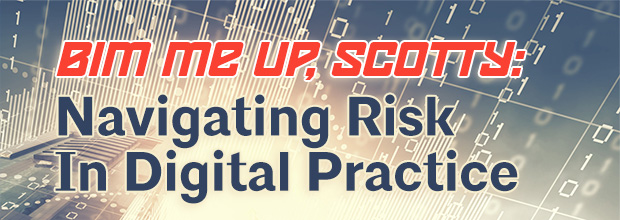The risk report, BIM Me Up, Scotty: Navigating Risk in Digital Practice, is your chance to get the inside on preemptive risk management for your digital travels. It is an opportunity to gain insight for managing your practice so that you can put up your deflector shields to guard against incursions from the litigious Borgs that inhabit your professional forcefield. It is logical, Captain.
The paper begins with the definition of BIM followed by the elements of BIM planning. The essential document for planning is known as a BIM Execution Plan or a BIM Protocol Manual, and an example is included with the paper to guide you. Levels of Development are used to establish a clear limitation on the complexity of the model, and definitions of the levels are addressed.
The AIA Digital Practice Documents – 2013 are addressed by following the Guide, Instructions and Commentary to the 2013 AIA Digital Practice Documents, a necessary and informative companion publication that you can use to navigate your path. Included in the updated documents are the Digital Data Exhibit, the Project Digital Data Protocol Form, the Project Building Information Modeling Protocol Form, the Digital Data Licensing Agreement, and Contractor BIM Sharing Agreement along with an explanation of the objectives of each document. The AIA Digital Practice Documents are recommended for your firm’s trajectory if you are considering BIM.
Practice Considerations are addressed from the standpoint of transitioning your firm from a 2D CAD environment to 3D BIM, although if it is your first time on the bridge, warp speed is not guaranteed since it is a complex process. Important areas of implementation, such as the design and production process, design and quality management content and systems, and IT infrastructure to address higher data volume, computing speed and file sizes are also addressed.
Suggestions for evaluating your prospective team members are offered, which includes consultants, contractors and owners. The rules are much the same as they were back when architects transitioned to 2D CAD from the pencil and parallel bar. And although BIM is not yet as much a threat as other areas of practice, potential risk areas are addressed, which include controlling the model, design coordination vs. construction coordination, construction tolerances, BIM shop drawings, and older form agreements, finishing with a discussion of the potentially evolving standard of care. To maintain your course heading, a useful BIM Execution Checklist is provided, as well as an example agreement for the contractor’s use of the BIM model.
This report can serve as a comprehensive BIM transition guide for the practitioner who wants to boldly go where he or she has never gone before. BIM and IPD may not be the final frontier, but they are quickly becoming the central platform for design, construction and building operation in the industry. Design professionals should seriously consider developing 3D CAD production status if they wish their practice to live long and prosper.
